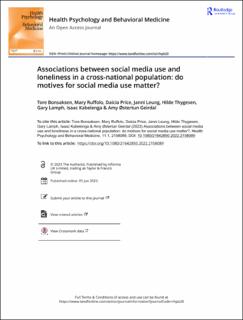| dc.contributor.author | Bonsaksen, Tore | |
| dc.contributor.author | Ruffolo, Mary | |
| dc.contributor.author | Price, Daicia | |
| dc.contributor.author | Leung, Janni | |
| dc.contributor.author | Thygesen, Hilde | |
| dc.contributor.author | Lamph, Gary | |
| dc.contributor.author | Kabelenga, Isaac | |
| dc.contributor.author | Geirdal, Amy Østertun | |
| dc.date.accessioned | 2023-02-03T12:03:22Z | |
| dc.date.available | 2023-02-03T12:03:22Z | |
| dc.date.created | 2022-12-05T16:37:15Z | |
| dc.date.issued | 2023 | |
| dc.identifier.citation | Health Psychology and Behavioral Medicine. 2023, 11 (1), | en_US |
| dc.identifier.issn | 2164-2850 | |
| dc.identifier.uri | https://hdl.handle.net/11250/3048291 | |
| dc.description | This is an Open Access article distributed under the terms of the Creative Commons Attribution-NonCommercial License (http:// creativecommons.org/licenses/by-nc/4.0/), which permits unrestricted non-commercial use, distribution, and reproduction in any medium, provided the original work is properly cited. | en_US |
| dc.description.abstract | Background: We aimed to examine the association between social media use and loneliness two years after the COVID-19 pandemic outbreak.
Methods: Participants were 1649 adults who completed a cross-sectional online survey disseminated openly in Norway, United Kingdom, USA, and Australia between November 2021 and January 2022. Linear regressions examined time spent on social media and participants’ characteristics on loneliness, and interactions by motives for social media use.
Results: Participants who worried more about their health and were younger, not employed, and without a spouse or partner reported higher levels of loneliness compared to their counterparts. More time spent on social media was associated with more loneliness (β = 0.12, p < 0.001). Three profile groups emerged for social media use motives: 1) social media use motive ratings on avoiding difficult feelings higher or the same as for maintaining contact; 2) slightly higher ratings for maintaining contact; and 3) substantially higher ratings for maintaining contact. Time spent on social media was significant only in motive profile groups 2 and 3 (β = 0.12 and β = 0.14, both p < 0.01).
Conclusions: Our findings suggest that people who use social media for the motive of maintaining their relationships feel lonelier than those who spend the same amount of time on social media for other reasons. While social media may facilitate social contact to a degree, they may not facilitate the type of contact sought by those who use social media primarily for this reason. | en_US |
| dc.language.iso | eng | en_US |
| dc.publisher | Taylor & Francis | en_US |
| dc.rights | Navngivelse-Ikkekommersiell 4.0 Internasjonal | * |
| dc.rights.uri | http://creativecommons.org/licenses/by-nc/4.0/deed.no | * |
| dc.subject | social media | en_US |
| dc.subject | moderation analysis | en_US |
| dc.subject | loneliness | en_US |
| dc.subject | cross-cultural study | en_US |
| dc.subject | COVID-19 | en_US |
| dc.title | Associations between social media use and loneliness in a cross-national population: Do motives for social media use matter? | en_US |
| dc.type | Peer reviewed | en_US |
| dc.type | Journal article | en_US |
| dc.description.version | publishedVersion | en_US |
| dc.rights.holder | © 2023 The Author(s). Published by Informa UK Limited, trading as Taylor & Francis Group | en_US |
| dc.source.volume | 11 | en_US |
| dc.source.journal | Health Psychology and Behavioral Medicine | en_US |
| dc.source.issue | 1 | en_US |
| dc.identifier.doi | 10.1080/21642850.2022.2158089 | |
| dc.identifier.cristin | 2089020 | |
| dc.source.articlenumber | 2158089 | en_US |
| cristin.ispublished | true | |
| cristin.fulltext | original | |
| cristin.qualitycode | 1 | |

